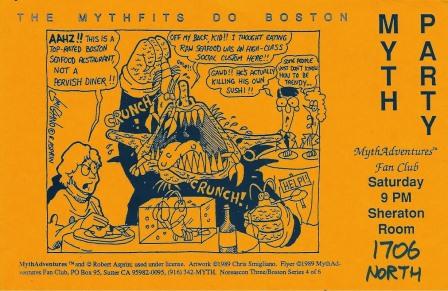
Myth Adventures Fan Club flyer by Christopher Smigliano advertising their Saturday night party at Noreascon Three.
Saturday at Noreascon Three. Third installment of my reminiscences about a once-in-a-generation convention that took place 25 years ago this week.
Lights, Camera, Inaction! Fire marshals threw a large monkey wrench into plans for opening the Art Show when they disapproved a lighting setup that had passed muster at other conventions. Not until Saturday was the con allowed to turn on the full array.
According to Chip Hitchcock in Instant Message #464: “At about 11 a.m. Thursday the hotel electrician and other people visited us and told us a lot of our things were unacceptable. One of the main concerns was a new city ordinance prohibiting unshielded bulbs, which might break if a 9-foot-tall fan bumped into them.”
Chairman Mark Olson explained, “The hotel did have concerns about fires; there was a genuine hotel room fire in a room in the South Tower [of the Sheraton] Wednesday morning, believed to have been caused by a TV set…”
Hitchcock continued: “The fire marshal arrived around 2 p.m. and questioned our fireworthiness. He wanted to see our hangings’ flameproofing certificate… Anton Chernoff thought he had it; went home and fortunately found it.” When the word went out the con found other help. “Teresa Renner remembered a gopher in Registration who was a fireman: Kurt Siegel of the Schenectady Fire Department, who talked fire departmentese to them and saved a lot of time. He also went across the street to the fire house and talked to the station master, getting his okay to open the show if we didn’t turn on our lights.”
To obtain reflectors to cover the bulbs the committee searched from Back Bay to San Francisco Bay. Said Hitchcock: “With the help of Tom Whitmore, Gary Feldbaum and I tracked down suppliers in the San Francisco area. At one point we had Frank Richards in a warehouse in Woburn and Monty [Wells] in the office in South Boston waving money at a wholesaler, finally convincing them it was OK to give the stuff at the warehouse to Frank.” It was early Saturday when the lights were completely ready.
When the lights went on the Art Show winners were:
Popular Choice
Best Artist (Professional): Michael Whelan
Best Artist (Professional) Honorable Mention: James Gurney
Best Artist (Amateur): Nevenah Smith
Best Artist (Amateur) Honorable Mention: Omar Rayyan
Chairman’s Choice: Michael Whelan, “Passage: The Red Step”
Honorable Mention: Tom Kidd, “Winsor McCay City”
Directors’ Choices: C. Anderson: Paul Chadwick, “Storming Heaven”; D. Anderson: Bob Eggleton, “Horsehead Nebula.”
Art Show Staff Choice
Bonnie Atwood, “Water Dance”
David A. Cherry, “A Stitch In Time”
Ruth Sanderson, “A Tale of Two Cities”
Honorable Mention
Barclay Shaw, “Euridice”
Arlin Robins, “Sea Dreams (Study)”
Vincent DiFate, “Popular Science (sketch – Voyager and Saturn)”
Take Me To The Captain of the Starship: Self-effacing, the Program Operations staff dubbed itself “Program Oops.” Priscilla Olson and Ben Yalow, who had spearheaded work in creating the Noreascon Three program, joined operations staff Fred Duarte, Karen Meschke and others to implement it smoothly. This included hearing people’s last-minute pitches to be added to existing program. “The only fan from Iceland” asked could he please have a free membership, in return for which he would be willing to talk about an ever-increasing list of topics. He grabbed passerby Fred Patten to intercede, who was counter-recruited to take “the only fan from Iceland” off and lose him. (However, other reports say the Icelandic fan appeared on the “Sherlock Holmes and SF” panel.)
Her diplomatic handling of Paul Edwards’ effort to insert himself onto already-full panels initiated one staffer into a peculiar Worldcon ritual. Chief of the Program Division Priscilla Olson declared, “You deserve a blue dot.” Priscilla pointed to her own badge which had nine tiny adhesive blue dots affixed. “Three of those are for Edwards,” she said. Called “Lichtenberg dots,” Seth Breidbart received the first one after contending with Jacqueline Lichtenberg’s Tarot reading setup.
Alexis Gilliland opined that “The SFWA Suite had all the warmth and intimacy of a zeppelin hangar. “ However, the Green Room in a corner alcove of the Hynes was graced by 30-foot-tall windows with an outstanding view of the city.
On The Stage and In The Audience: “The Closing of the American Mind” included panelists Greg Benford and David Brin. Francis Hamit attended and reports, “At one point Neil Rest and others in back started booing and yelling at Brin for reasons I could not discern.”
The audience for Saturday’s 10 a.m. running of Orson Scott Card’s “1000 Ideas An Hour” included Janice Gelb who reports: “[During] the first half of the panel he created a believable story with help from the audience, and explained why suggestions do or don’t work.” Card determined for the last half whether to concentrate on science fiction or fantasy depending on a vote of the audience. Out of about 80 fans present, only 12 voted for fantasy, prompting Card to joke, “I should have known; the fantasy people can’t get up this early. They’ve got to stay up until after midnight to check mirrors for reflections!” For the balance of the program he collaborated with the audience to create a believable alien. The group invented two symbiotic animals. One runs fast (after a joke someone made about alien cannibals doing it to get an endorphin fix) and the second mates on the other’s back and lives there.
Gelb also reported that “The 60-Hour Grind” was theoretically about how to handle your full-time job and develop creative talent in your spare time. “Pat Cadigan had quit her job a few years before, and one other panelist had been unemployed for some time. Despite these anomalies the panel went fairly well, with members of the audience chiming in with their own horror stories. One panelist explain[ed] that the idea for the first story he ever sold came to him while he was a naval officer and was enduring Prisoner of War simulation!”
Sitting in the front row at the “Worldcons – Should We Kill Them Before They Kill Us?” panel was Gene Wolfe. When moderator Priscilla Olson was harangued by Linda Bushyager for having too much programming at Noreascon (over 600 items), Wolfe interceded to say he likes the redundancy of items with similar topics so that when he’s forced to choose one program over another he may still have a chance to hear discussion of what he missed later on.
Doug Crepeau, one of Mike Jittlov’s publicists, fished for some good response to the showing of Wizard of Speed and Time at the con. However, Gavin Claypool reported the Sunday showing was canceled. We learned later that was not because of poor attendance or the lukewarm review in a Boston paper. A local distributor rented the print to replace another film doing poorly in one of his movie houses and Wizard ran successfully for three weeks.
“All Our Children” featured discussion on fringe fandoms between Fred Patten, knowledgeable about comics and Japanimation fandoms, and Lois Mangan, a media fan. Janice Gelb moderated, terming the program “mainly a defense by media fans (“We do so read”) and some historical background on various fannish schisms by [Patten].”
Mr. Yalow Meets Mr. Murphy: Things ran smoothly enough that Fred Duarte was hard-pressed to think of any problems handled by Program Operations – oh, except one. It seems at one program they’d furnished an insufficiently powerful slide projector to penetrate the smoked glass in the projection booth window. They scrounged up another one and the panel started 20 minutes late. Division head Ben Yalow himself took this problem in hand. After all, the speaker was a famous scientist – Dr. Rosalyn Yalow.
Another Episode of Elst Weinstein’s Lobster Surgical Theater: Saturday night after I closed the fanzine sales table with the help of Tony Ubelhor, I joined the Ross Pavlac expedition to the No Name Restaurant, accompanied by Elst, Hope Leibowitz, Tom Veal, Becky Thomson and another couple. As Becky was a convention official at the information table it was yeoman work getting her away from a swarm of folk in search of her advice and orders. Even as Ross dragged Becky away bodily she obliviously continued calling out instructions to someone, “You can call my beeper –“ at which point her beeper vanished and Pavlac’s hand went over her mouth. Getting Becky down to the car to go to the restaurant was at least as much work for Ross as kidnapping Candice Bergen was for Sean Connery in The Wind and The Lion.
There was heated discussion over the menu of this famous Boston seafood restaurant, opened in 1917, and Elst Weinstein told Hope, “Get scrod.” [Not sure why I thought it was mandatory to repeat this joke, which already appeared once in the conreport.]
Ignoring Elst, several people ordered lobster and even persuaded the good doctor (Weinstein, not Asimov) to give them surgical tips for extracting the meat.
During dinner I learned that the business meeting approved Bruce Pelz’ Hugo preservation committee. With northeastern fans always full of ideas for how profitable Worldcons should spend their money, I said I was surprised they stopped at just funding a study committee. They could just as well have gotten a grant from Worldcon Atlanta Inc. to send the winners themselves to a taxidermist. Elst rejoined, “First we stuffed the ballots. Now we’ll stuff the winners.”
Filled with wonderful seafood, we helled back to the Sheraton in taxis: I had to get to the Hugo ceremony!
Ghod Blesh Saint Fantony: Noreascon’s novel Hugo ceremony required all nominees to rendezvous beforehand in Hynes 200, the function room near the stage entrance to the auditorium.
Hugo nominees, in case they won, received a laser printed diagram of how to approach the stage, where Fred Pohl would hand them the award, where to pause at midstage for photographers, and where to find the steps at the far side of the stage. It looked like a Minnesota Fats bank shot, or Stephen Hawking’s line drawing of the Big Bang. I still haven’t figured out the stage diagram. Or the Big Bang.
The ceremonies started with a procession of the nominees grouped by award category and led by a knight of St. Fantony1 bearing a Hugo rocket. How much time did the nominees have to absorb these directions? Remember the old Xerox commercial where the coach sends in Kolodny with copies of a last-minute play?2 We had about that much time.
A member of the committee in a tangerine evening gown tried to shout directions over the din of gossipy pros and fans. Saying, “We will start with the Fan Artist nominees –“ her words were so twisted in the babel that when she repeated them Gardner Dozois said in surprise, “I thought you said faint-hearted nominees—“ and Lucius Shepard claimed to have heard “wannabees.”
While we were backstage being herded together in categories, Jill Eastlake was onstage explaining the traditions of the knights of St. Fantony; we couldn’t make out word one but the muffled tones sounded quite reverent.
I marched in with the fanwriters, and don’t let them tell you it’s not a small world for there I was walking beside none other than NOLAcon’s Justin Winston, seconding the absent Guy Lillian III. Dick Eney in his knightly pastel green garb and brass headband led us. Dick showed his knightly virtue by not asking me where in heck is Fancyclopedia 3 anyway.3
For me, the pretention level of the ceremony had already crossed the redline and I just lost it when I got to the door and heard our processional music was “March of the Gladiators” from Spartacus or something comparable with brassy flourishes and rhythms suited to the stride of captured war elephants.
We walked circuitously through the auditorium like extras in a Hercules movie. Nominees in the professional categories marched at the end. Gardner Dozois basked in the applause, flashing a V-sign at the crowd like Winston Churchill on V-E Day. In his white tuxedo George Alec Effinger looked like he’d gotten lost on his way to the top layer of a wedding cake.
Donald Eastlake III came last in line carrying a purple banner: GHOD BLESH SAINT FANTONY. He stood it beside the larger St. Fantony and Noreascon Three banners already on stage.
Master of ceremonies Fred Pohl began by explaining that he was standing in for the Ballantines, because Ian’s health difficulties of a few months earlier militated against them continuing as emcees. When Pohl mentioned the Ballantines 2,000 fans and writers applauded loudly. Pohl replied, “You can applaud some more because I’m going to say some more nice things about them.” He reviewed their mid-1940s groundbreaking efforts in the science fiction paperback field, ascribing their efforts to drive and talent, and “one other essential ingredient: They paid more than anybody else.”
Noreascon Three presented two Special Awards. One went to artist Alex Schomburg and was accepted by his granddaughter who read the artist’s letter of thanks. The other went to the computer-based service SF Lovers Digest, accepted by its current moderator Saul Jaffe. Jaffe thanked Rutgers University for its facilities.

Rusty Hevelin(left) and Forrest J Ackerman (right) at Noreascon 3. Photo by Robert Sneddon from Fanac.org site.
Apropos of the 50th Anniversary Worldcon, Fred Pohl introduced the Big Heart Award presenter, Forrest J Ackerman, as “the first fan to wear a costume, outside a secure institution, anyway.” Forry presented the Big Heart Award to Art Widner.
Robert Madle tried to present three First Fandom Awards to L. Sprague De Camp, Don Grant and Fred Pohl, but found he didn’t have the award plaques because he’d neglected to call on three other First Fandomites holding the winners’ plaques, Art Saha, Isaac Asimov and Lloyd Arthur Eshbach. When that was corrected, to much huffing by Art Saha, the presentations were made.
Isaac Asimov introduced De Camp’s award. He teased that the “requirements” of First Fandom are “great age, a withered appearance, and miserable habits. We keep Fred Pohl around as an example.”
Not to be surpassed even by the great Asimov, Pohl told the story of being at a conference with Asimov when a young woman walked up, looked at Isaac’s badge, and twinkled, ‘Oh: you’re Isaac Asimov…. What do you do?’” Pohl gazed at Asimov. “Don’t get me started. I know more Isaac Asimov stories than Harlan Ellison stories.” The audience gasped to think there could be that much material…
Takumi Shibano introduced colleagues from Japan who gave out two Seiun Awards to North American winners not present at the Japanese national convention. Winner of the Best Novel translated into Japanese was Footfall by Niven and Pournelle. Winner of the Best Short Story translated into Japanese was “Eye for Eye” by Orson Scott Card. The physical Seiun Award is something uniquely designed by each year’s committee. This year it appeared to be a small white urn, and Shibano confessed he didn’t know the significance himself.
Andre Norton received thunderous applause when she came onstage to present the award she created and funded. The Gryphon Award goes to the best unpublished fantasy by a woman. The physical award is a white gryphon embedded in a hefty Lucite block, and its winner was Elizabeth Waters. There is also an honor book award, which went to Lee Barwood.
Analog editor Stanley Schmidt presented the John W. Campbell Award for best new writer to Michaela Roessner. Then Fred Pohl began handing out the Hugo Awards.
Best Fan Artist was shared by Brad Foster and Diana Gallagher Wu, who tied with 201 votes apiece. Dave Langford won Best Fanwriter, his acceptance speech (read by Martin Hoare) saying, “Now I can die happy once I’ve been asked to contribute to Last Dangerous Visions.”
To my surprise and delight, File 770 won Best Fanzine. Hearing Fred Pohl introduce the category with comments about the fanzine exhibit, including the fanzine reading area I’d arranged, I decided to use the opportunity to ask people to come see it. Regrettably, I phrased things so broadly that I seemed to be strongarming the credit for the whole area and ignoring Nancy Atherton’s organization of the historic fanzine exhibit. I’m told at that moment all right-thinking people in the balcony simultaneously muttered, “You asshole!” particularly Debbie Notkin and Spike Parsons who looked me up the next day to tell me so. I apologized to Nancy and inserted a correction in the daily newzine.
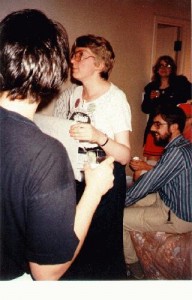
Caroline Mullan (center) and Peter Weston (seated) at Tea Party II during Noreascon 3. Photo by Robert Sneddon from Fanac.org site.
Best Semiprozine went to Locus. I wondered whether Charlie Brown ever did any maintenance on his Hugos. Not that it ever occurred to me they needed any until British fan Peter Weston, whose company has been manufacturing the Hugo rockets since 1984, took me aside. He had seen my Hugos in Bruce Pelz’ display and complained they were getting tarnished and ought to be polished. I told him that’s all I needed was to have some friends drop in and catch me polishing my Hugos!
After Michael Whelan accepted the Best Professional Artist Hugo, Fred told a story about the 1966 Worldcon in Cleveland. They shared the convention hotel with a group of World War II veterans. Pohl got stuck in an elevator with 15 people: the vets sobbed and pounded on the walls shouting, “For the love of God, Montresor!” while the fans just said, “Let’s do some filk!” The hotel got them out by bringing the other elevator car alongside, taking out the walls, and inviting them to step across eight stories of empty space.
Gardner Dozois accepted the Best Professional Editor Hugo. Producer Frank Marshall was on hand to pick up the Best Dramatic Presentation rocket for Who Framed Roger Rabbit. Samuel Delany delightedly received the Best Nonfiction Book Hugo for The Motion of Light in Water. A happy Mike Resnick was stunned into uncharacteristic speechlessness by his first Hugo, for his short story “Kirinyaga.”
Not even the finest novel of his career and a home-town Worldcon could swing a Hugo for George Alec Effinger in 1988, but in Boston he was not only summoned to accept the Best Novelette Hugo for “Schrodinger’s Kitten,” he outpolled his friend Harlan Ellison’s story in the bargain.
In his white tuxedo Effinger fell somewhere on the spectrum between Mark Twain and John Travolta, yet his acceptance sounded peculiarly like Gary Cooper in a famous movie, complete with faked mike reverb: “Some folks say I’ve had a bad break. But today I feel like I’m the luckiest man on the face of the earth, earth, earth.” Sitting next to me was Vancouver’s Fran Skene whose knowledge of American baseball extends little beyond her delight that W.P. Kinsella lives in British Columbia. I told her in a pithy sentence about Lou Gehrig and Fran’s scowl of distaste for Effinger’s humor said it all.
Brandishing his Hugo, Effinger had one last remark: “Mike Resnick and I have just begun collaborating on a novel and these two awards are going to cost somebody a lot.”
Connie Willis’ “Last of the Winnebagos” won the Best Novella Hugo. Connie said that after seeing the Locus photo of her Nebula win she swore if she won a Hugo she “would not be photographed smiling like a chipmunk from ear to ear,” but she abandoned her resolve in the happiness of the moment.
Best Novel went to C.J. Cherryh for Cyteen and she thanked a list of people beginning with “my alpha reader, Jane [Fancher].”
There was the usual orgy of photography after the ceremony. A lot of fans stayed in their seats for the promised Who Framed Roger Rabbit? and Batman double-bill. I circled back to the press area for a copy of George Flynn’s excellent press kit with releases about the pro winners and complete voting statistics. Then I found an elevator bound for Keith Kato’s chili party.

Robert Silverberg (left) and Ralph Vicinanza (right) at Noreascon 3. Photo by Robert Sneddon from Fanac.org site.
The Legendary Keith Kato: Once upon a time Keith Kato was a physics student and science fiction fan who discovered this natural law: if you feed Robert Silverberg sufficiently good chili, he will attend all your parties. In fact, the young Kato spent years perfecting his “Silverberg grade” hot chili and in the process met any number of sf writers including Gregory Benford, who became an advisor on Kato’s Ph.D. committee.
For years Kato hauled his cooking pots and hot plates around the country and spent Hugo day in his room cooking meat and simmering chili, oblivious to the smell of hot oil wafting down the entire corridor as far as the elevators, and hoping Housekeeping was the same. Keith tried to retire once mainly because of the unkissed toads who crashed his parties and never even thanked him.
Fortunately he came back. Before I started to actually win the things, the best part of Hugo night was to be invited to Kato’s party, eat chili, listen to writers’ shop talk, and meet an eclectic mix of international fans from Japan to Norway and everywhere in between. I have been going to them long enough that it was fated I should learn the inner secrets of Keith’s process. First, I ran into Keith at a market next to the convention center filling a shopping cart with cheese and vegetables. “I’m buying all the perishables,” he explained, and I confess it bothered me to discover there were non-perishable ingredients in his chili. At the party, as I hovered over the bathtub, shoving aside the ice-cold imported beers in search of a Diet Pepsi, I heard Kato explaining to Ashley Grayson, “Nobody realizes I cook chili in my swimming trunks.” Without expression Grayson replied, “How do you keep it from running out?”
jan howard finder came in with word the Kees Van Toorn’s noisy ConFiction4 party had just been closed down by Sheraton management. finder took the opportunity to report on the success of several benefit auctions run at Noreascon Three. He said the ASFA auction yielded $3,500 from the sale of 285 items. jan sounded breathless from having run 172 items in the first two hours of the auction.
The daily newzine later reported that the ConFiction party was “partially evacuated twice by hotel staff due to the vast numbers of enthusiastic supporters who came to enjoy real Dutch hospitality and a great bar, featuring 160-proof double-distilled rum known as Stroh.” The rum was available by the glass or in a vanilla/praline cake prepared by Carol Shetler and Larry van der Putte. In spite of the Sheraton, Larry kept the party running until 5 a.m. in the morning.
Tom Hanlon reported pros complained the Bantam Books party was cordoned off by hotel security. They were eventually moved to a larger and cooler room on a non-sleeping-room floor.
Chairman Mark Olson said Sunday night, “We were very, very happy with the treatment we received from the Hynes and the Sheraton.” Compared to the specter of Hotel Hostility raised when the Sheraton originally tried to kick out the Worldcon, the degree of cooperation showed by the hotel was apparently very satisfactory. Despite that, a number of parties were closed.
The committee relied heavily on volunteer elevator monitors to prevent overcrowding. The recruiting pitch in the daily newzine asked, “Do you like standing in small rooms with total strangers? If so, you’re just the person we’re looking for.” For once the newzine’s black humor was exceeded by a grimmer reality. Monitors took a lot of mindless abuse: I heard it, and it was disgusting. The worst case I witnessed involved one idiot who not merely insisted on riding an elevator that a monitor warned had jammed earlier, but loudly abused the monitor and dragged the nearest person to the door to ride with him as an assertion of “hotel customers’ rights.”
Elevator monitors address a real problem, but as Joe Rico summed up, “Without elevator management, elevators are slow, crowded and inefficient. With elevator management, elevators are slow, crowded and inefficient, but at least somebody notes it in the Ops log.”
Saturday Night’s All Right For Fightin’: Unlikely as it seems that George Alec Effinger would need to stray very far from his home in New Orleans’ French Quarter in search of exotic pleasure, and even more unlikely that he would find it in Boston, he found his heart’s desire at a Boston Red Sox game. His friend Debbie Hodgkinson mentioned they got into a tiff: “George is off in baseball land. He got mad when I called it Fenwick.”
Effinger was even more emotional about the reception for his 1988 Hugo-nominated novel When Gravity Fails: he is thoroughly outraged by the lack of promotion for his books. Said George, “People keep coming up to me asking when the sequel to Gravity is going to be out – and it’s been out for THREE MONTHS!!”
Effinger was soothed to learn the sequel, A Fire In The Sun, was featured in the window of a nearby bookstore. George’s calm was short-lived, though, for after the Hugo ceremony a passing fan asked him if the Hugo in his arms was bought in the Art Show.
Notes
1. Not sure that the Fancyclopedia’s article about the Order of St. Fantony really makes clear what it is, but it’s a long entry.
2. YouTube has a copy of Xerox’s Kolodny commercial.
3. In the 1980s I was still part of the Fancyclopedia 3 editorial project. Today it’s a wiki site under completely different and obviously successful management because I can actually look stuff up on it!
4. ConFiction was the next year’s – 1990 – Worldcon.
5. The Myth Adventures Fan Club party flyer included above is one of a series of six by Christopher Smigliano. The entire set is online here.
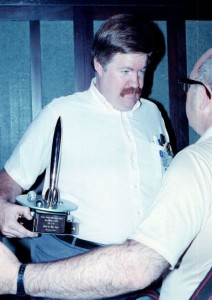
Here Jay Kay Klein (right) interrupts photographing the 1989 Hugo winners long enough to give me a piece of his mind. I must deserve it — do I look guilty, or what? Photo by Julee Johnson Tate.
Discover more from File 770
Subscribe to get the latest posts to your email.

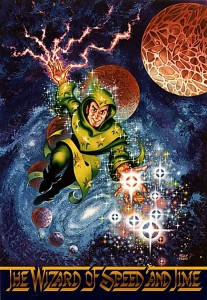
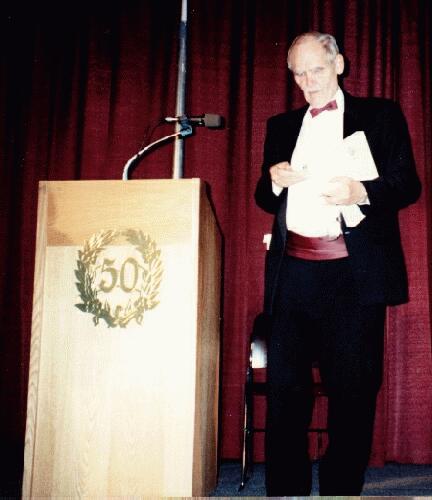

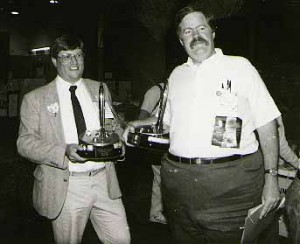
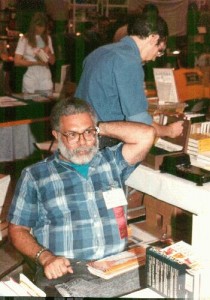
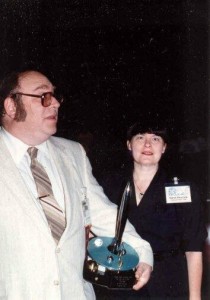
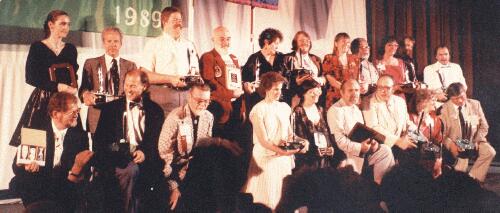
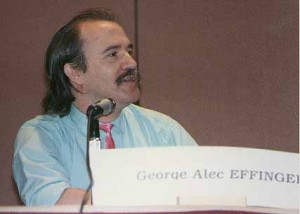
Ignoring most of the typos in the above, I can’t help marveling at “Getting Becky down to the can to go to the restaurant”, and I feel compelled to point out the misspellings of Nevenah Smith’s and Omar Rayyan’s names.
Wow, that MAFC flyer was marked up by me — my handwriting hasn’t changed much — for our party there. Chris Smigliano was the person I use in an oft-told-by-me story whose punch line is “I’ve lived in counties that are bigger than your whole state!”
Morris: “I have always relied on the kindness of strangers who are proofreaders.” Thanks for the quick note!
Kevin: I thought you would get a kick out of seeing that flyer at the top.
Wow, quotes from my con reports back when I actually had time to go to programming!
Thanks, brings it all back…
I’m reading through some of the newsletters now in our photo album of the con. My wife was the newsletter editor and was wrote many of those bits of black humor as “The Bread-And-Butter Fly”.
I’m chuckling at an item from Issue 6 on Saturday afternoon –
“The Bread-And-Butter Fly got quite a jolt this morning. For one wild moment it thought that it had overdone it last night and landed in the hospital. But no, the blue band was only from the Louis Wu party.” (referencing the blue admission/age check wristbands used by Boxboro).